Business Process Modelling
VerifiedAdded on 2023/06/12
|12
|3333
|105
AI Summary
This article discusses the most common organizational structures, functional and enterprise information systems, procurement process, made to order and made to stock strategies, and the impact of globalization on organizations. It also explains the difference between a Bill of Material and Product Routing, and the problems associated with manual or paper-based business processes. The article concludes with an explanation of the SAP environment and the difference between Organizational Master and Transactional data.
Contribute Materials
Your contribution can guide someone’s learning journey. Share your
documents today.
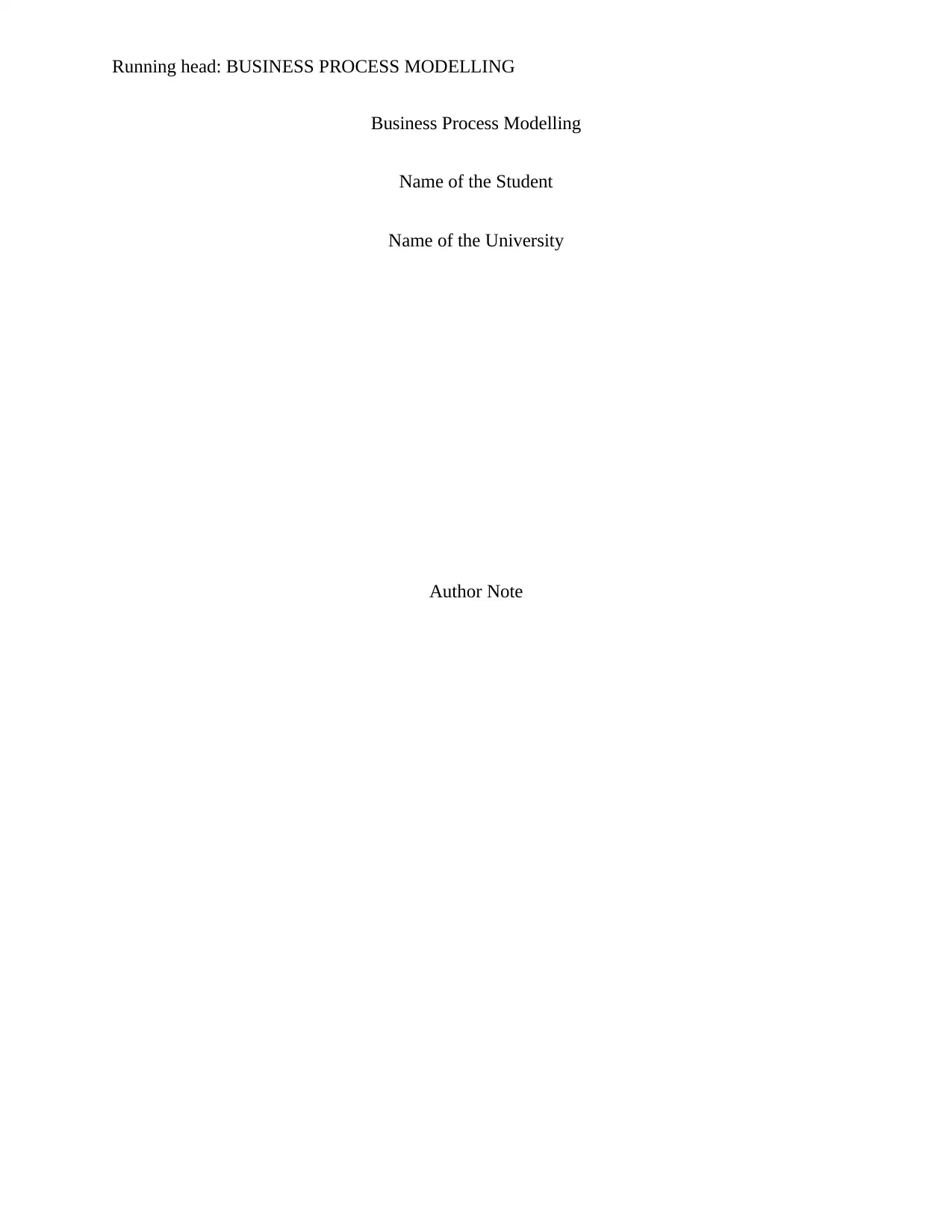
Running head: BUSINESS PROCESS MODELLING
Business Process Modelling
Name of the Student
Name of the University
Author Note
Business Process Modelling
Name of the Student
Name of the University
Author Note
Secure Best Marks with AI Grader
Need help grading? Try our AI Grader for instant feedback on your assignments.
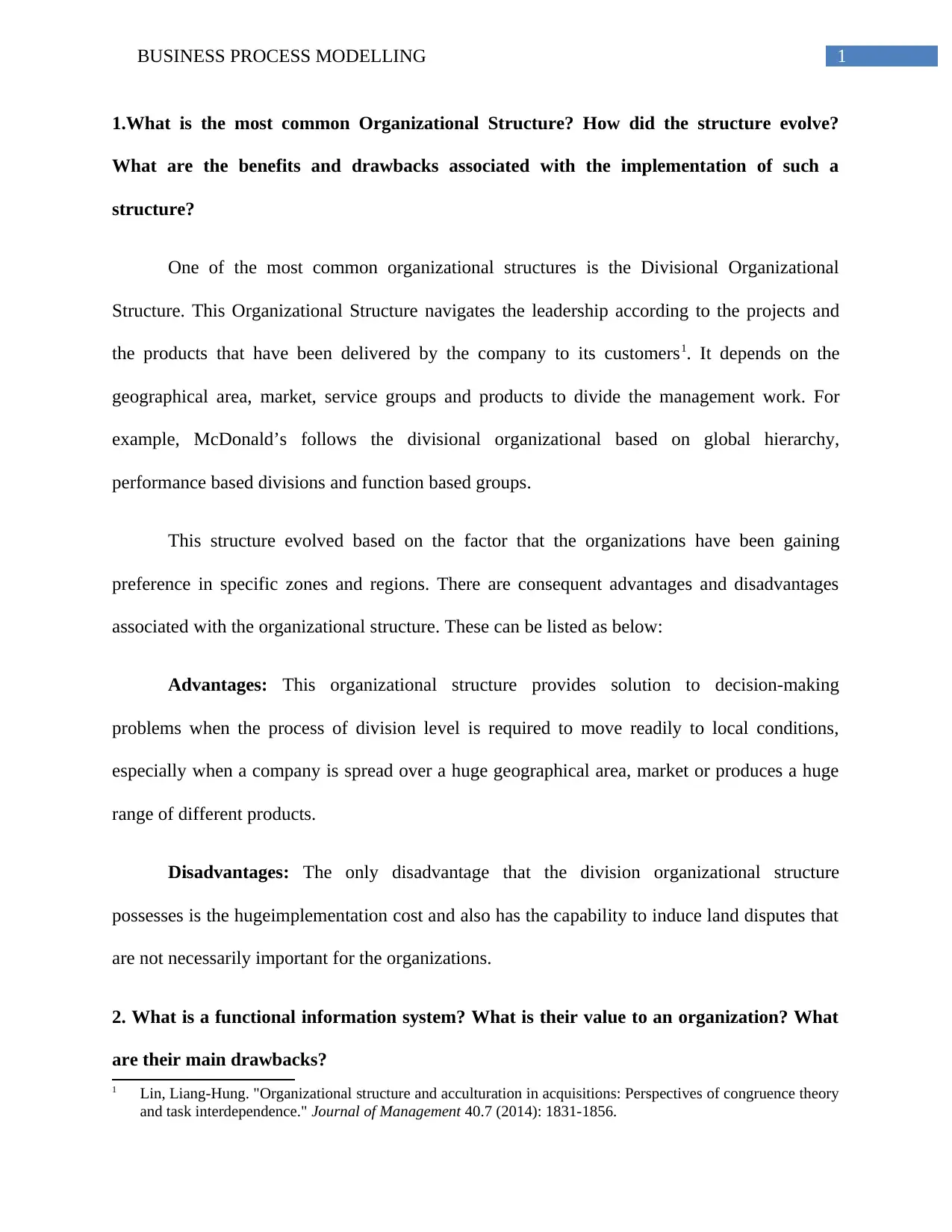
1BUSINESS PROCESS MODELLING
1.What is the most common Organizational Structure? How did the structure evolve?
What are the benefits and drawbacks associated with the implementation of such a
structure?
One of the most common organizational structures is the Divisional Organizational
Structure. This Organizational Structure navigates the leadership according to the projects and
the products that have been delivered by the company to its customers1. It depends on the
geographical area, market, service groups and products to divide the management work. For
example, McDonald’s follows the divisional organizational based on global hierarchy,
performance based divisions and function based groups.
This structure evolved based on the factor that the organizations have been gaining
preference in specific zones and regions. There are consequent advantages and disadvantages
associated with the organizational structure. These can be listed as below:
Advantages: This organizational structure provides solution to decision-making
problems when the process of division level is required to move readily to local conditions,
especially when a company is spread over a huge geographical area, market or produces a huge
range of different products.
Disadvantages: The only disadvantage that the division organizational structure
possesses is the hugeimplementation cost and also has the capability to induce land disputes that
are not necessarily important for the organizations.
2. What is a functional information system? What is their value to an organization? What
are their main drawbacks?
1 Lin, Liang-Hung. "Organizational structure and acculturation in acquisitions: Perspectives of congruence theory
and task interdependence." Journal of Management 40.7 (2014): 1831-1856.
1.What is the most common Organizational Structure? How did the structure evolve?
What are the benefits and drawbacks associated with the implementation of such a
structure?
One of the most common organizational structures is the Divisional Organizational
Structure. This Organizational Structure navigates the leadership according to the projects and
the products that have been delivered by the company to its customers1. It depends on the
geographical area, market, service groups and products to divide the management work. For
example, McDonald’s follows the divisional organizational based on global hierarchy,
performance based divisions and function based groups.
This structure evolved based on the factor that the organizations have been gaining
preference in specific zones and regions. There are consequent advantages and disadvantages
associated with the organizational structure. These can be listed as below:
Advantages: This organizational structure provides solution to decision-making
problems when the process of division level is required to move readily to local conditions,
especially when a company is spread over a huge geographical area, market or produces a huge
range of different products.
Disadvantages: The only disadvantage that the division organizational structure
possesses is the hugeimplementation cost and also has the capability to induce land disputes that
are not necessarily important for the organizations.
2. What is a functional information system? What is their value to an organization? What
are their main drawbacks?
1 Lin, Liang-Hung. "Organizational structure and acculturation in acquisitions: Perspectives of congruence theory
and task interdependence." Journal of Management 40.7 (2014): 1831-1856.
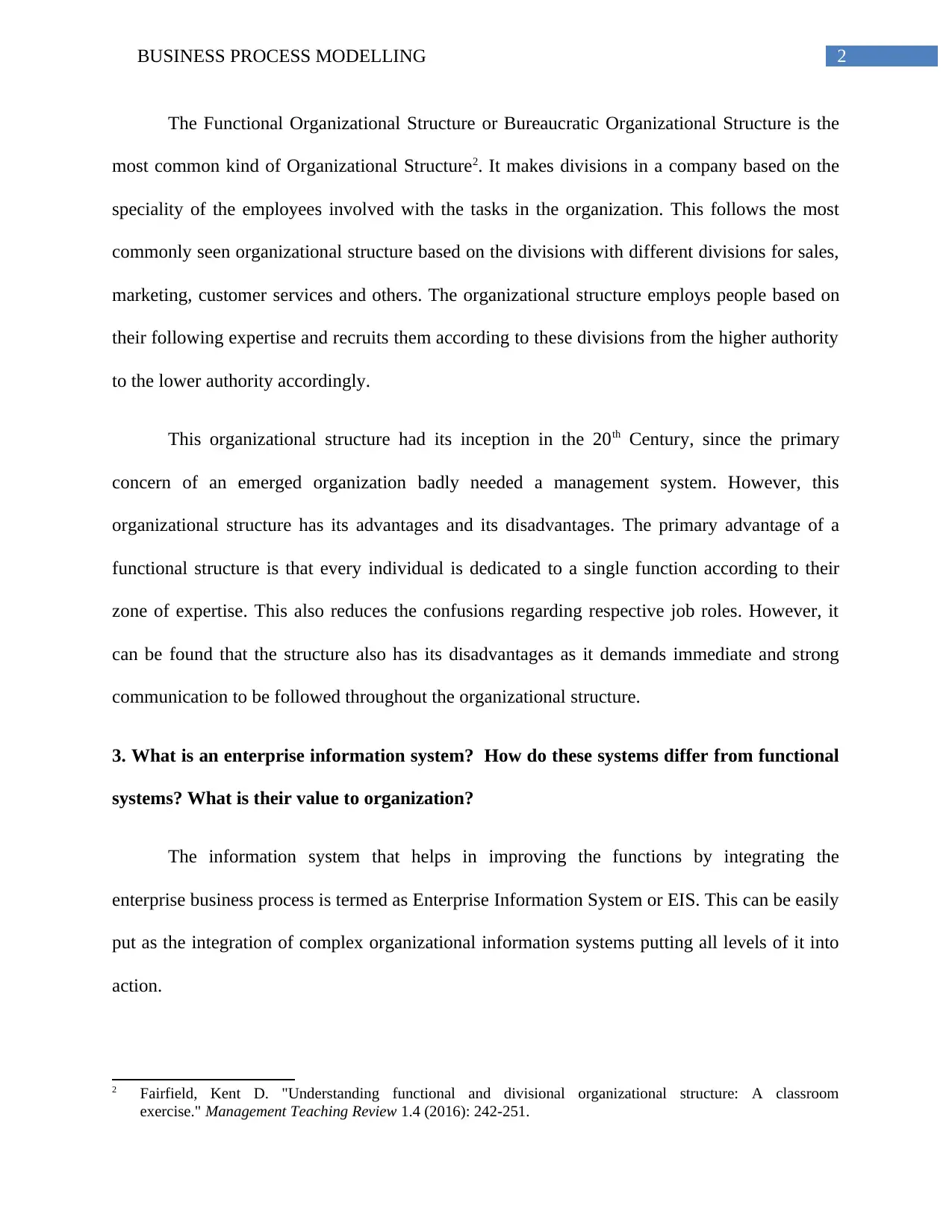
2BUSINESS PROCESS MODELLING
The Functional Organizational Structure or Bureaucratic Organizational Structure is the
most common kind of Organizational Structure2. It makes divisions in a company based on the
speciality of the employees involved with the tasks in the organization. This follows the most
commonly seen organizational structure based on the divisions with different divisions for sales,
marketing, customer services and others. The organizational structure employs people based on
their following expertise and recruits them according to these divisions from the higher authority
to the lower authority accordingly.
This organizational structure had its inception in the 20th Century, since the primary
concern of an emerged organization badly needed a management system. However, this
organizational structure has its advantages and its disadvantages. The primary advantage of a
functional structure is that every individual is dedicated to a single function according to their
zone of expertise. This also reduces the confusions regarding respective job roles. However, it
can be found that the structure also has its disadvantages as it demands immediate and strong
communication to be followed throughout the organizational structure.
3. What is an enterprise information system? How do these systems differ from functional
systems? What is their value to organization?
The information system that helps in improving the functions by integrating the
enterprise business process is termed as Enterprise Information System or EIS. This can be easily
put as the integration of complex organizational information systems putting all levels of it into
action.
2 Fairfield, Kent D. "Understanding functional and divisional organizational structure: A classroom
exercise." Management Teaching Review 1.4 (2016): 242-251.
The Functional Organizational Structure or Bureaucratic Organizational Structure is the
most common kind of Organizational Structure2. It makes divisions in a company based on the
speciality of the employees involved with the tasks in the organization. This follows the most
commonly seen organizational structure based on the divisions with different divisions for sales,
marketing, customer services and others. The organizational structure employs people based on
their following expertise and recruits them according to these divisions from the higher authority
to the lower authority accordingly.
This organizational structure had its inception in the 20th Century, since the primary
concern of an emerged organization badly needed a management system. However, this
organizational structure has its advantages and its disadvantages. The primary advantage of a
functional structure is that every individual is dedicated to a single function according to their
zone of expertise. This also reduces the confusions regarding respective job roles. However, it
can be found that the structure also has its disadvantages as it demands immediate and strong
communication to be followed throughout the organizational structure.
3. What is an enterprise information system? How do these systems differ from functional
systems? What is their value to organization?
The information system that helps in improving the functions by integrating the
enterprise business process is termed as Enterprise Information System or EIS. This can be easily
put as the integration of complex organizational information systems putting all levels of it into
action.
2 Fairfield, Kent D. "Understanding functional and divisional organizational structure: A classroom
exercise." Management Teaching Review 1.4 (2016): 242-251.
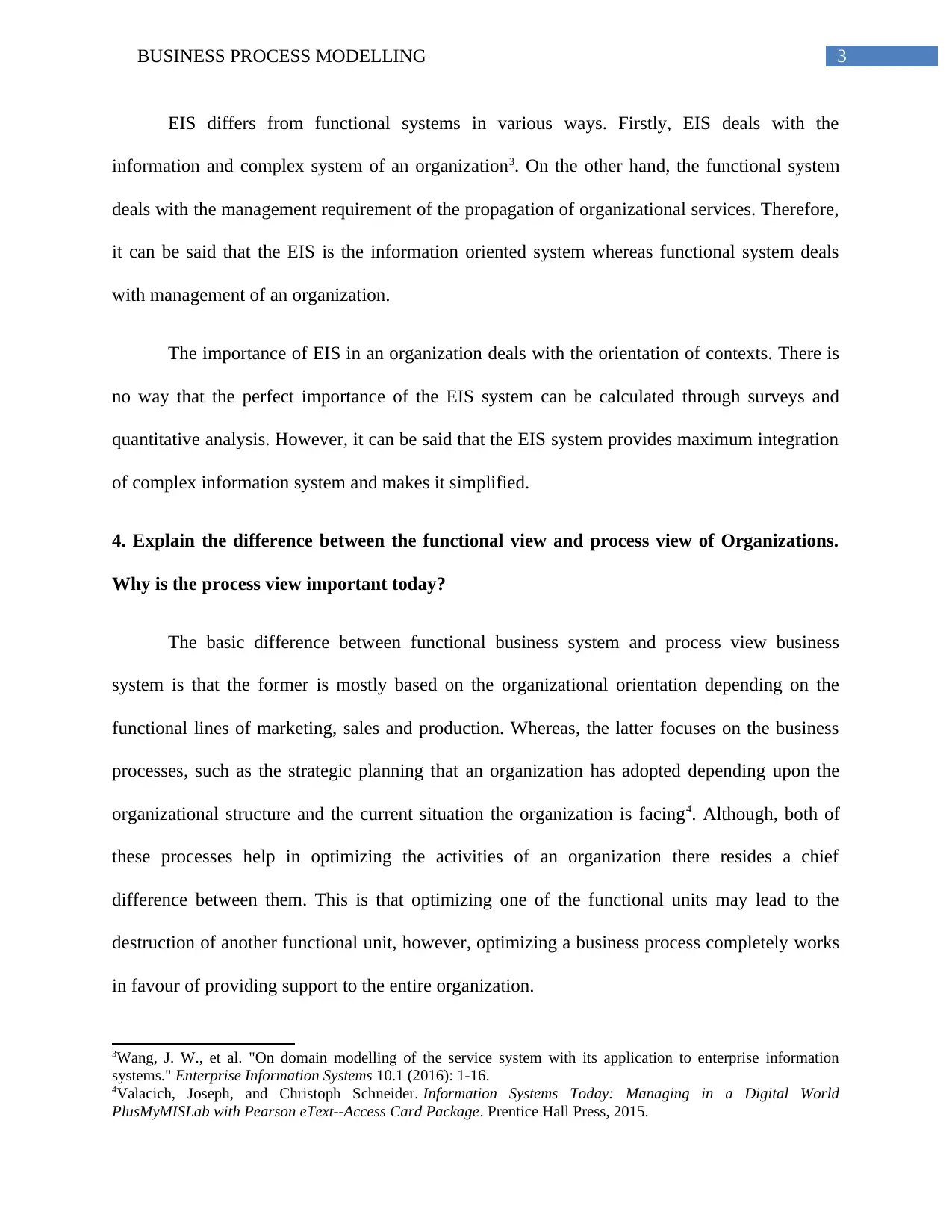
3BUSINESS PROCESS MODELLING
EIS differs from functional systems in various ways. Firstly, EIS deals with the
information and complex system of an organization3. On the other hand, the functional system
deals with the management requirement of the propagation of organizational services. Therefore,
it can be said that the EIS is the information oriented system whereas functional system deals
with management of an organization.
The importance of EIS in an organization deals with the orientation of contexts. There is
no way that the perfect importance of the EIS system can be calculated through surveys and
quantitative analysis. However, it can be said that the EIS system provides maximum integration
of complex information system and makes it simplified.
4. Explain the difference between the functional view and process view of Organizations.
Why is the process view important today?
The basic difference between functional business system and process view business
system is that the former is mostly based on the organizational orientation depending on the
functional lines of marketing, sales and production. Whereas, the latter focuses on the business
processes, such as the strategic planning that an organization has adopted depending upon the
organizational structure and the current situation the organization is facing4. Although, both of
these processes help in optimizing the activities of an organization there resides a chief
difference between them. This is that optimizing one of the functional units may lead to the
destruction of another functional unit, however, optimizing a business process completely works
in favour of providing support to the entire organization.
3Wang, J. W., et al. "On domain modelling of the service system with its application to enterprise information
systems." Enterprise Information Systems 10.1 (2016): 1-16.
4Valacich, Joseph, and Christoph Schneider. Information Systems Today: Managing in a Digital World
PlusMyMISLab with Pearson eText--Access Card Package. Prentice Hall Press, 2015.
EIS differs from functional systems in various ways. Firstly, EIS deals with the
information and complex system of an organization3. On the other hand, the functional system
deals with the management requirement of the propagation of organizational services. Therefore,
it can be said that the EIS is the information oriented system whereas functional system deals
with management of an organization.
The importance of EIS in an organization deals with the orientation of contexts. There is
no way that the perfect importance of the EIS system can be calculated through surveys and
quantitative analysis. However, it can be said that the EIS system provides maximum integration
of complex information system and makes it simplified.
4. Explain the difference between the functional view and process view of Organizations.
Why is the process view important today?
The basic difference between functional business system and process view business
system is that the former is mostly based on the organizational orientation depending on the
functional lines of marketing, sales and production. Whereas, the latter focuses on the business
processes, such as the strategic planning that an organization has adopted depending upon the
organizational structure and the current situation the organization is facing4. Although, both of
these processes help in optimizing the activities of an organization there resides a chief
difference between them. This is that optimizing one of the functional units may lead to the
destruction of another functional unit, however, optimizing a business process completely works
in favour of providing support to the entire organization.
3Wang, J. W., et al. "On domain modelling of the service system with its application to enterprise information
systems." Enterprise Information Systems 10.1 (2016): 1-16.
4Valacich, Joseph, and Christoph Schneider. Information Systems Today: Managing in a Digital World
PlusMyMISLab with Pearson eText--Access Card Package. Prentice Hall Press, 2015.
Secure Best Marks with AI Grader
Need help grading? Try our AI Grader for instant feedback on your assignments.
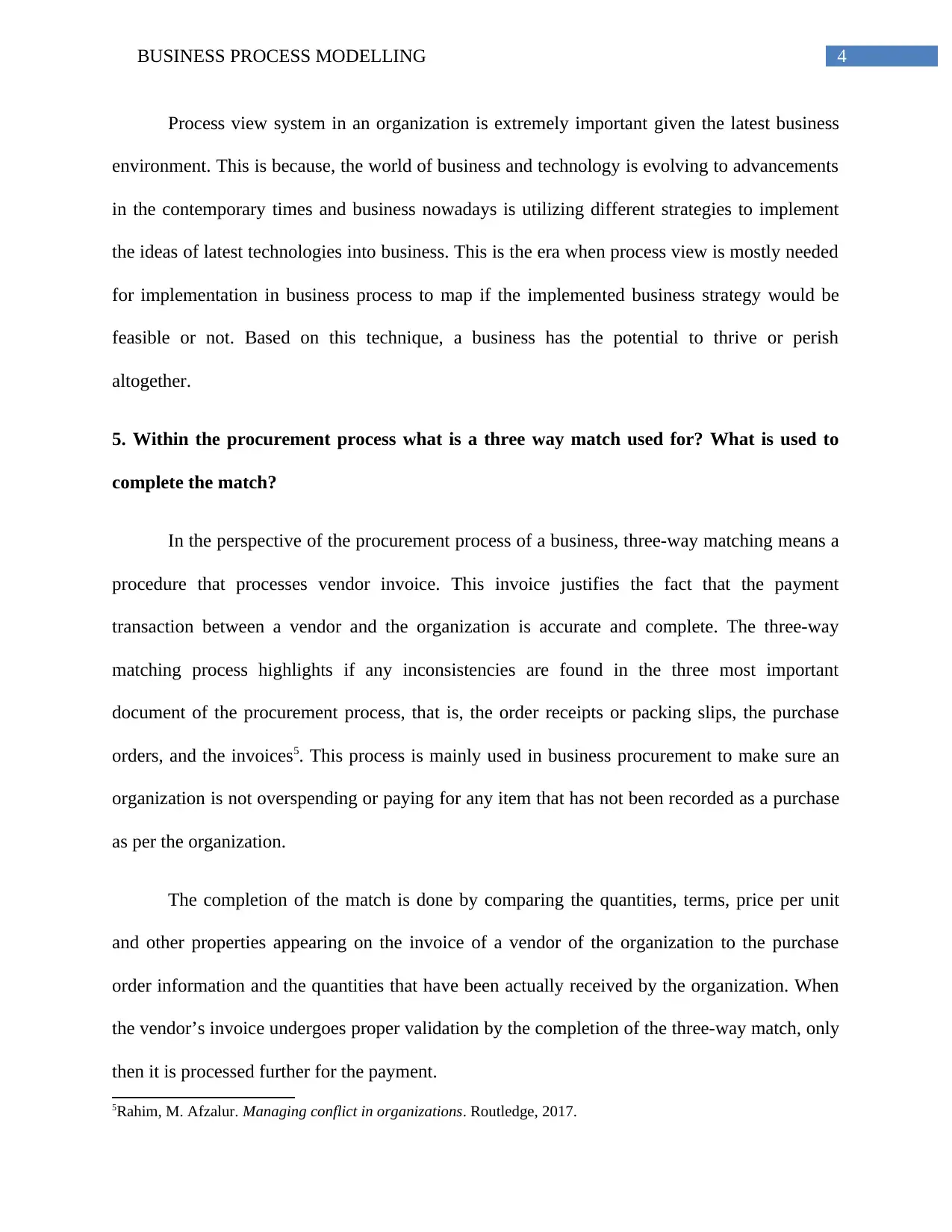
4BUSINESS PROCESS MODELLING
Process view system in an organization is extremely important given the latest business
environment. This is because, the world of business and technology is evolving to advancements
in the contemporary times and business nowadays is utilizing different strategies to implement
the ideas of latest technologies into business. This is the era when process view is mostly needed
for implementation in business process to map if the implemented business strategy would be
feasible or not. Based on this technique, a business has the potential to thrive or perish
altogether.
5. Within the procurement process what is a three way match used for? What is used to
complete the match?
In the perspective of the procurement process of a business, three-way matching means a
procedure that processes vendor invoice. This invoice justifies the fact that the payment
transaction between a vendor and the organization is accurate and complete. The three-way
matching process highlights if any inconsistencies are found in the three most important
document of the procurement process, that is, the order receipts or packing slips, the purchase
orders, and the invoices5. This process is mainly used in business procurement to make sure an
organization is not overspending or paying for any item that has not been recorded as a purchase
as per the organization.
The completion of the match is done by comparing the quantities, terms, price per unit
and other properties appearing on the invoice of a vendor of the organization to the purchase
order information and the quantities that have been actually received by the organization. When
the vendor’s invoice undergoes proper validation by the completion of the three-way match, only
then it is processed further for the payment.
5Rahim, M. Afzalur. Managing conflict in organizations. Routledge, 2017.
Process view system in an organization is extremely important given the latest business
environment. This is because, the world of business and technology is evolving to advancements
in the contemporary times and business nowadays is utilizing different strategies to implement
the ideas of latest technologies into business. This is the era when process view is mostly needed
for implementation in business process to map if the implemented business strategy would be
feasible or not. Based on this technique, a business has the potential to thrive or perish
altogether.
5. Within the procurement process what is a three way match used for? What is used to
complete the match?
In the perspective of the procurement process of a business, three-way matching means a
procedure that processes vendor invoice. This invoice justifies the fact that the payment
transaction between a vendor and the organization is accurate and complete. The three-way
matching process highlights if any inconsistencies are found in the three most important
document of the procurement process, that is, the order receipts or packing slips, the purchase
orders, and the invoices5. This process is mainly used in business procurement to make sure an
organization is not overspending or paying for any item that has not been recorded as a purchase
as per the organization.
The completion of the match is done by comparing the quantities, terms, price per unit
and other properties appearing on the invoice of a vendor of the organization to the purchase
order information and the quantities that have been actually received by the organization. When
the vendor’s invoice undergoes proper validation by the completion of the three-way match, only
then it is processed further for the payment.
5Rahim, M. Afzalur. Managing conflict in organizations. Routledge, 2017.
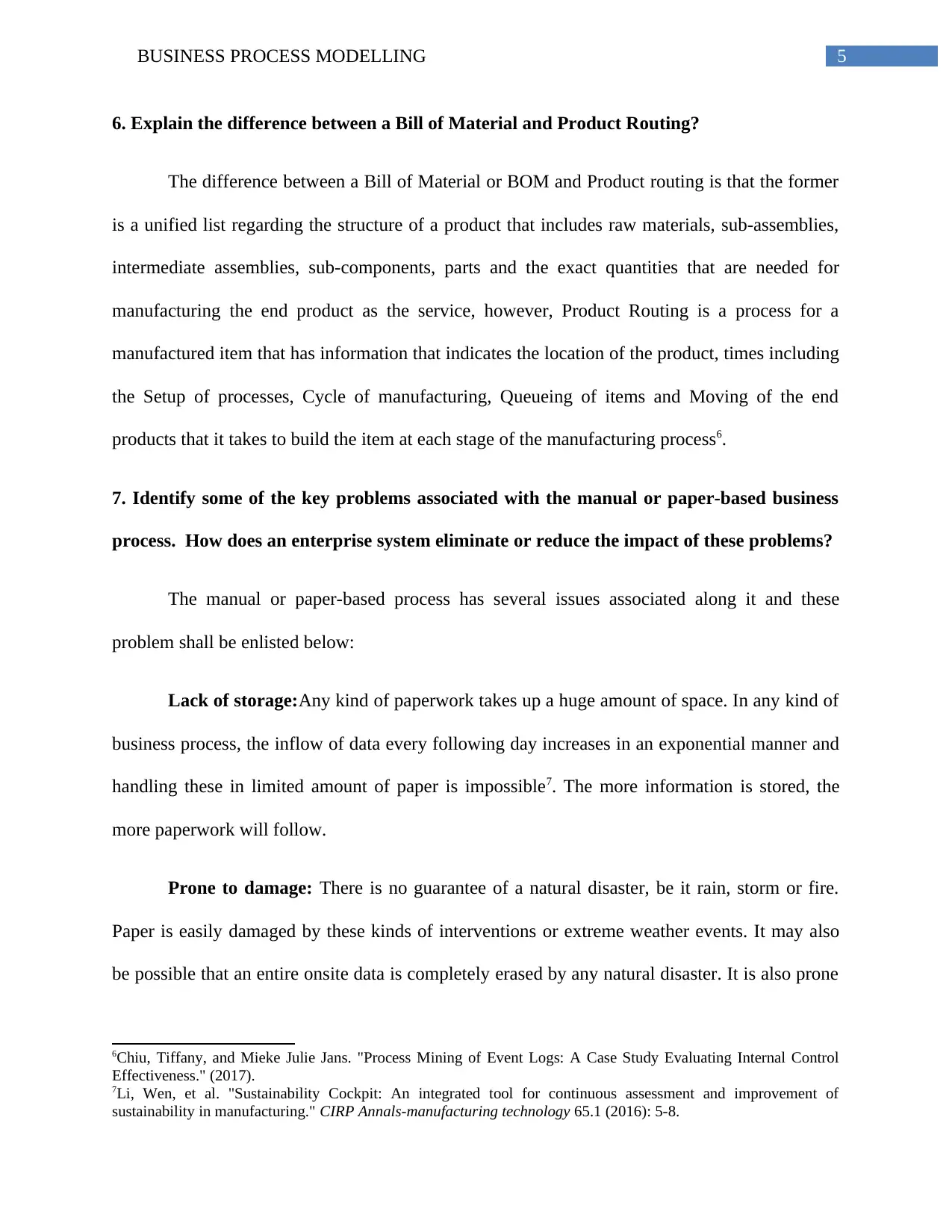
5BUSINESS PROCESS MODELLING
6. Explain the difference between a Bill of Material and Product Routing?
The difference between a Bill of Material or BOM and Product routing is that the former
is a unified list regarding the structure of a product that includes raw materials, sub-assemblies,
intermediate assemblies, sub-components, parts and the exact quantities that are needed for
manufacturing the end product as the service, however, Product Routing is a process for a
manufactured item that has information that indicates the location of the product, times including
the Setup of processes, Cycle of manufacturing, Queueing of items and Moving of the end
products that it takes to build the item at each stage of the manufacturing process6.
7. Identify some of the key problems associated with the manual or paper-based business
process. How does an enterprise system eliminate or reduce the impact of these problems?
The manual or paper-based process has several issues associated along it and these
problem shall be enlisted below:
Lack of storage:Any kind of paperwork takes up a huge amount of space. In any kind of
business process, the inflow of data every following day increases in an exponential manner and
handling these in limited amount of paper is impossible7. The more information is stored, the
more paperwork will follow.
Prone to damage: There is no guarantee of a natural disaster, be it rain, storm or fire.
Paper is easily damaged by these kinds of interventions or extreme weather events. It may also
be possible that an entire onsite data is completely erased by any natural disaster. It is also prone
6Chiu, Tiffany, and Mieke Julie Jans. "Process Mining of Event Logs: A Case Study Evaluating Internal Control
Effectiveness." (2017).
7Li, Wen, et al. "Sustainability Cockpit: An integrated tool for continuous assessment and improvement of
sustainability in manufacturing." CIRP Annals-manufacturing technology 65.1 (2016): 5-8.
6. Explain the difference between a Bill of Material and Product Routing?
The difference between a Bill of Material or BOM and Product routing is that the former
is a unified list regarding the structure of a product that includes raw materials, sub-assemblies,
intermediate assemblies, sub-components, parts and the exact quantities that are needed for
manufacturing the end product as the service, however, Product Routing is a process for a
manufactured item that has information that indicates the location of the product, times including
the Setup of processes, Cycle of manufacturing, Queueing of items and Moving of the end
products that it takes to build the item at each stage of the manufacturing process6.
7. Identify some of the key problems associated with the manual or paper-based business
process. How does an enterprise system eliminate or reduce the impact of these problems?
The manual or paper-based process has several issues associated along it and these
problem shall be enlisted below:
Lack of storage:Any kind of paperwork takes up a huge amount of space. In any kind of
business process, the inflow of data every following day increases in an exponential manner and
handling these in limited amount of paper is impossible7. The more information is stored, the
more paperwork will follow.
Prone to damage: There is no guarantee of a natural disaster, be it rain, storm or fire.
Paper is easily damaged by these kinds of interventions or extreme weather events. It may also
be possible that an entire onsite data is completely erased by any natural disaster. It is also prone
6Chiu, Tiffany, and Mieke Julie Jans. "Process Mining of Event Logs: A Case Study Evaluating Internal Control
Effectiveness." (2017).
7Li, Wen, et al. "Sustainability Cockpit: An integrated tool for continuous assessment and improvement of
sustainability in manufacturing." CIRP Annals-manufacturing technology 65.1 (2016): 5-8.
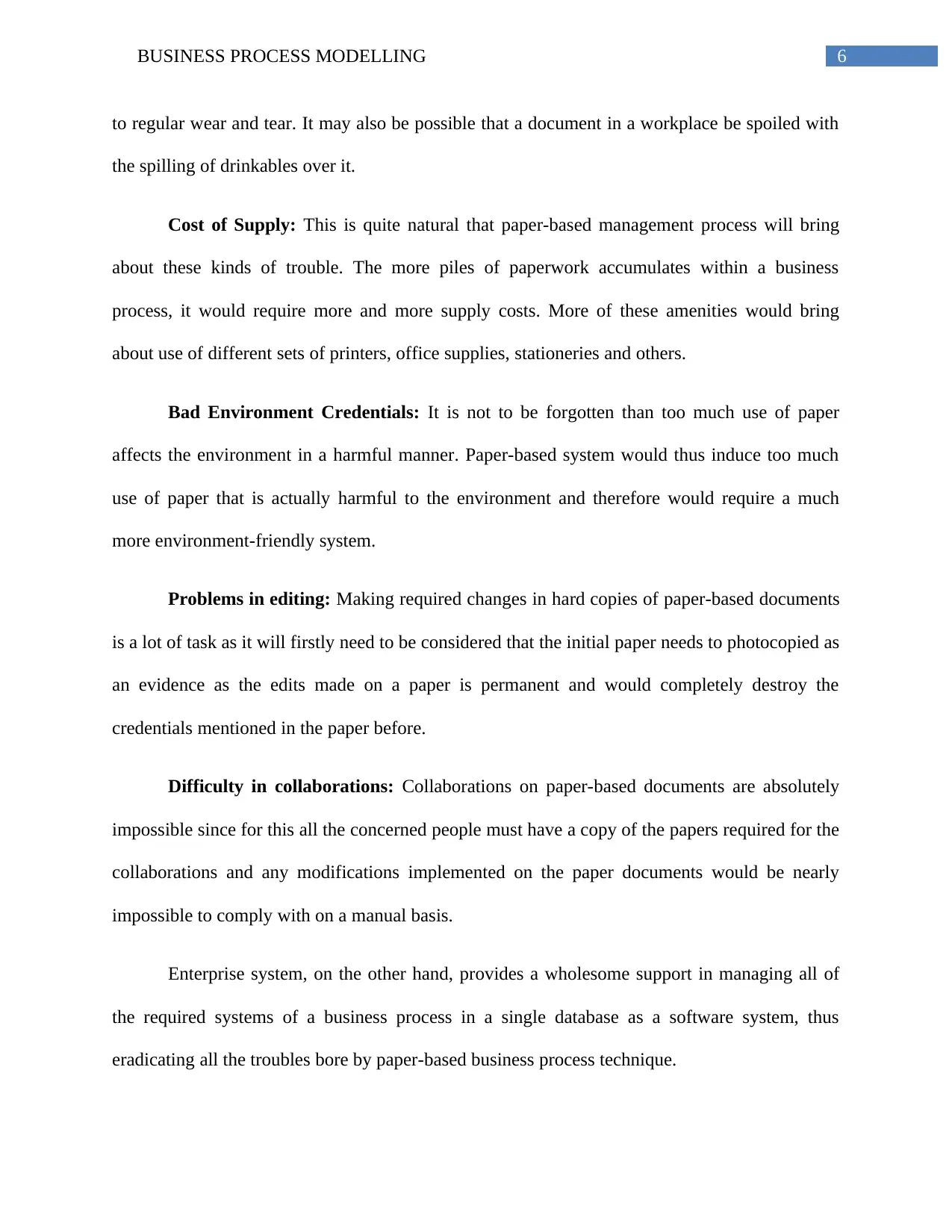
6BUSINESS PROCESS MODELLING
to regular wear and tear. It may also be possible that a document in a workplace be spoiled with
the spilling of drinkables over it.
Cost of Supply: This is quite natural that paper-based management process will bring
about these kinds of trouble. The more piles of paperwork accumulates within a business
process, it would require more and more supply costs. More of these amenities would bring
about use of different sets of printers, office supplies, stationeries and others.
Bad Environment Credentials: It is not to be forgotten than too much use of paper
affects the environment in a harmful manner. Paper-based system would thus induce too much
use of paper that is actually harmful to the environment and therefore would require a much
more environment-friendly system.
Problems in editing: Making required changes in hard copies of paper-based documents
is a lot of task as it will firstly need to be considered that the initial paper needs to photocopied as
an evidence as the edits made on a paper is permanent and would completely destroy the
credentials mentioned in the paper before.
Difficulty in collaborations: Collaborations on paper-based documents are absolutely
impossible since for this all the concerned people must have a copy of the papers required for the
collaborations and any modifications implemented on the paper documents would be nearly
impossible to comply with on a manual basis.
Enterprise system, on the other hand, provides a wholesome support in managing all of
the required systems of a business process in a single database as a software system, thus
eradicating all the troubles bore by paper-based business process technique.
to regular wear and tear. It may also be possible that a document in a workplace be spoiled with
the spilling of drinkables over it.
Cost of Supply: This is quite natural that paper-based management process will bring
about these kinds of trouble. The more piles of paperwork accumulates within a business
process, it would require more and more supply costs. More of these amenities would bring
about use of different sets of printers, office supplies, stationeries and others.
Bad Environment Credentials: It is not to be forgotten than too much use of paper
affects the environment in a harmful manner. Paper-based system would thus induce too much
use of paper that is actually harmful to the environment and therefore would require a much
more environment-friendly system.
Problems in editing: Making required changes in hard copies of paper-based documents
is a lot of task as it will firstly need to be considered that the initial paper needs to photocopied as
an evidence as the edits made on a paper is permanent and would completely destroy the
credentials mentioned in the paper before.
Difficulty in collaborations: Collaborations on paper-based documents are absolutely
impossible since for this all the concerned people must have a copy of the papers required for the
collaborations and any modifications implemented on the paper documents would be nearly
impossible to comply with on a manual basis.
Enterprise system, on the other hand, provides a wholesome support in managing all of
the required systems of a business process in a single database as a software system, thus
eradicating all the troubles bore by paper-based business process technique.
Paraphrase This Document
Need a fresh take? Get an instant paraphrase of this document with our AI Paraphraser
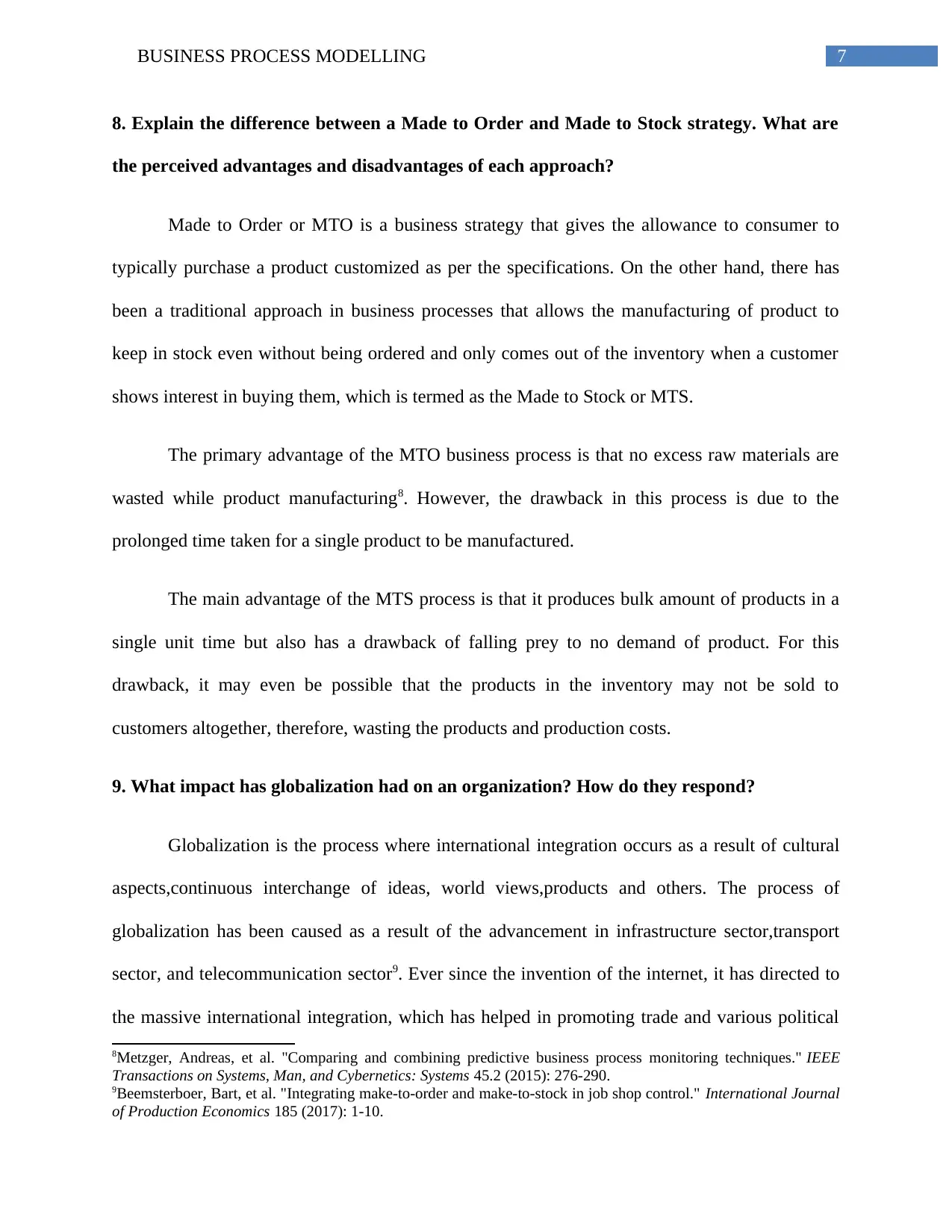
7BUSINESS PROCESS MODELLING
8. Explain the difference between a Made to Order and Made to Stock strategy. What are
the perceived advantages and disadvantages of each approach?
Made to Order or MTO is a business strategy that gives the allowance to consumer to
typically purchase a product customized as per the specifications. On the other hand, there has
been a traditional approach in business processes that allows the manufacturing of product to
keep in stock even without being ordered and only comes out of the inventory when a customer
shows interest in buying them, which is termed as the Made to Stock or MTS.
The primary advantage of the MTO business process is that no excess raw materials are
wasted while product manufacturing8. However, the drawback in this process is due to the
prolonged time taken for a single product to be manufactured.
The main advantage of the MTS process is that it produces bulk amount of products in a
single unit time but also has a drawback of falling prey to no demand of product. For this
drawback, it may even be possible that the products in the inventory may not be sold to
customers altogether, therefore, wasting the products and production costs.
9. What impact has globalization had on an organization? How do they respond?
Globalization is the process where international integration occurs as a result of cultural
aspects,continuous interchange of ideas, world views,products and others. The process of
globalization has been caused as a result of the advancement in infrastructure sector,transport
sector, and telecommunication sector9. Ever since the invention of the internet, it has directed to
the massive international integration, which has helped in promoting trade and various political
8Metzger, Andreas, et al. "Comparing and combining predictive business process monitoring techniques." IEEE
Transactions on Systems, Man, and Cybernetics: Systems 45.2 (2015): 276-290.
9Beemsterboer, Bart, et al. "Integrating make-to-order and make-to-stock in job shop control." International Journal
of Production Economics 185 (2017): 1-10.
8. Explain the difference between a Made to Order and Made to Stock strategy. What are
the perceived advantages and disadvantages of each approach?
Made to Order or MTO is a business strategy that gives the allowance to consumer to
typically purchase a product customized as per the specifications. On the other hand, there has
been a traditional approach in business processes that allows the manufacturing of product to
keep in stock even without being ordered and only comes out of the inventory when a customer
shows interest in buying them, which is termed as the Made to Stock or MTS.
The primary advantage of the MTO business process is that no excess raw materials are
wasted while product manufacturing8. However, the drawback in this process is due to the
prolonged time taken for a single product to be manufactured.
The main advantage of the MTS process is that it produces bulk amount of products in a
single unit time but also has a drawback of falling prey to no demand of product. For this
drawback, it may even be possible that the products in the inventory may not be sold to
customers altogether, therefore, wasting the products and production costs.
9. What impact has globalization had on an organization? How do they respond?
Globalization is the process where international integration occurs as a result of cultural
aspects,continuous interchange of ideas, world views,products and others. The process of
globalization has been caused as a result of the advancement in infrastructure sector,transport
sector, and telecommunication sector9. Ever since the invention of the internet, it has directed to
the massive international integration, which has helped in promoting trade and various political
8Metzger, Andreas, et al. "Comparing and combining predictive business process monitoring techniques." IEEE
Transactions on Systems, Man, and Cybernetics: Systems 45.2 (2015): 276-290.
9Beemsterboer, Bart, et al. "Integrating make-to-order and make-to-stock in job shop control." International Journal
of Production Economics 185 (2017): 1-10.
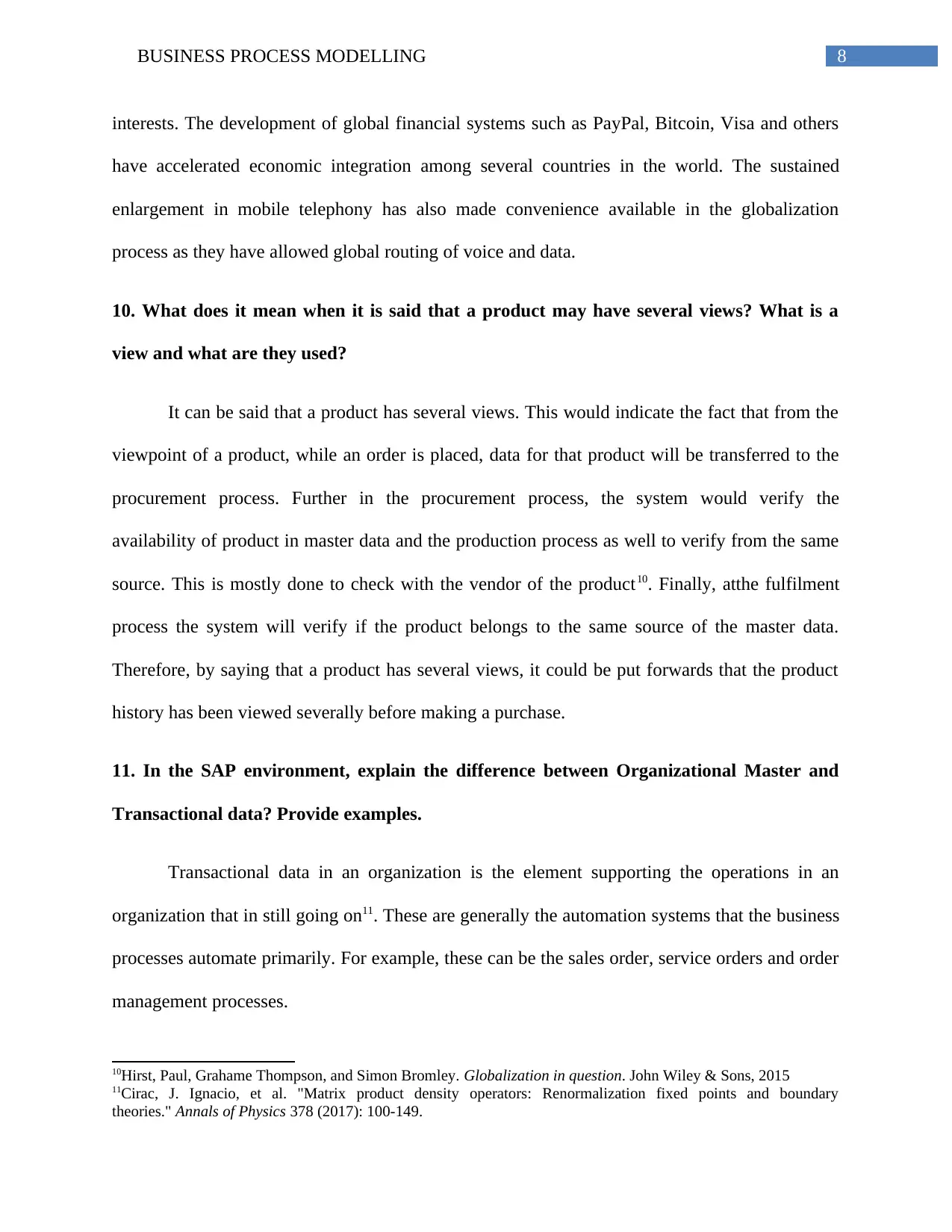
8BUSINESS PROCESS MODELLING
interests. The development of global financial systems such as PayPal, Bitcoin, Visa and others
have accelerated economic integration among several countries in the world. The sustained
enlargement in mobile telephony has also made convenience available in the globalization
process as they have allowed global routing of voice and data.
10. What does it mean when it is said that a product may have several views? What is a
view and what are they used?
It can be said that a product has several views. This would indicate the fact that from the
viewpoint of a product, while an order is placed, data for that product will be transferred to the
procurement process. Further in the procurement process, the system would verify the
availability of product in master data and the production process as well to verify from the same
source. This is mostly done to check with the vendor of the product10. Finally, atthe fulfilment
process the system will verify if the product belongs to the same source of the master data.
Therefore, by saying that a product has several views, it could be put forwards that the product
history has been viewed severally before making a purchase.
11. In the SAP environment, explain the difference between Organizational Master and
Transactional data? Provide examples.
Transactional data in an organization is the element supporting the operations in an
organization that in still going on11. These are generally the automation systems that the business
processes automate primarily. For example, these can be the sales order, service orders and order
management processes.
10Hirst, Paul, Grahame Thompson, and Simon Bromley. Globalization in question. John Wiley & Sons, 2015
11Cirac, J. Ignacio, et al. "Matrix product density operators: Renormalization fixed points and boundary
theories." Annals of Physics 378 (2017): 100-149.
interests. The development of global financial systems such as PayPal, Bitcoin, Visa and others
have accelerated economic integration among several countries in the world. The sustained
enlargement in mobile telephony has also made convenience available in the globalization
process as they have allowed global routing of voice and data.
10. What does it mean when it is said that a product may have several views? What is a
view and what are they used?
It can be said that a product has several views. This would indicate the fact that from the
viewpoint of a product, while an order is placed, data for that product will be transferred to the
procurement process. Further in the procurement process, the system would verify the
availability of product in master data and the production process as well to verify from the same
source. This is mostly done to check with the vendor of the product10. Finally, atthe fulfilment
process the system will verify if the product belongs to the same source of the master data.
Therefore, by saying that a product has several views, it could be put forwards that the product
history has been viewed severally before making a purchase.
11. In the SAP environment, explain the difference between Organizational Master and
Transactional data? Provide examples.
Transactional data in an organization is the element supporting the operations in an
organization that in still going on11. These are generally the automation systems that the business
processes automate primarily. For example, these can be the sales order, service orders and order
management processes.
10Hirst, Paul, Grahame Thompson, and Simon Bromley. Globalization in question. John Wiley & Sons, 2015
11Cirac, J. Ignacio, et al. "Matrix product density operators: Renormalization fixed points and boundary
theories." Annals of Physics 378 (2017): 100-149.
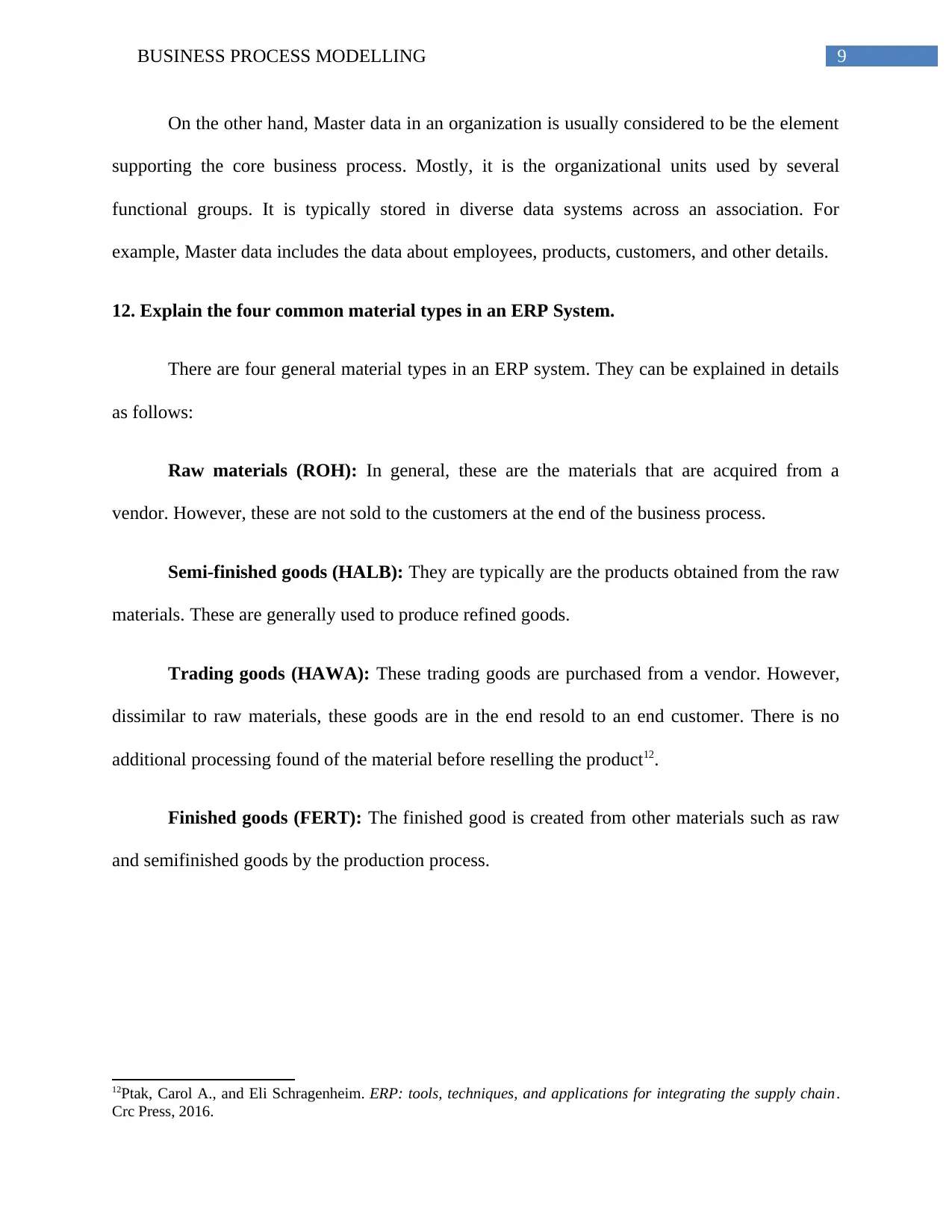
9BUSINESS PROCESS MODELLING
On the other hand, Master data in an organization is usually considered to be the element
supporting the core business process. Mostly, it is the organizational units used by several
functional groups. It is typically stored in diverse data systems across an association. For
example, Master data includes the data about employees, products, customers, and other details.
12. Explain the four common material types in an ERP System.
There are four general material types in an ERP system. They can be explained in details
as follows:
Raw materials (ROH): In general, these are the materials that are acquired from a
vendor. However, these are not sold to the customers at the end of the business process.
Semi-finished goods (HALB): They are typically are the products obtained from the raw
materials. These are generally used to produce refined goods.
Trading goods (HAWA): These trading goods are purchased from a vendor. However,
dissimilar to raw materials, these goods are in the end resold to an end customer. There is no
additional processing found of the material before reselling the product12.
Finished goods (FERT): The finished good is created from other materials such as raw
and semifinished goods by the production process.
12Ptak, Carol A., and Eli Schragenheim. ERP: tools, techniques, and applications for integrating the supply chain.
Crc Press, 2016.
On the other hand, Master data in an organization is usually considered to be the element
supporting the core business process. Mostly, it is the organizational units used by several
functional groups. It is typically stored in diverse data systems across an association. For
example, Master data includes the data about employees, products, customers, and other details.
12. Explain the four common material types in an ERP System.
There are four general material types in an ERP system. They can be explained in details
as follows:
Raw materials (ROH): In general, these are the materials that are acquired from a
vendor. However, these are not sold to the customers at the end of the business process.
Semi-finished goods (HALB): They are typically are the products obtained from the raw
materials. These are generally used to produce refined goods.
Trading goods (HAWA): These trading goods are purchased from a vendor. However,
dissimilar to raw materials, these goods are in the end resold to an end customer. There is no
additional processing found of the material before reselling the product12.
Finished goods (FERT): The finished good is created from other materials such as raw
and semifinished goods by the production process.
12Ptak, Carol A., and Eli Schragenheim. ERP: tools, techniques, and applications for integrating the supply chain.
Crc Press, 2016.
Secure Best Marks with AI Grader
Need help grading? Try our AI Grader for instant feedback on your assignments.
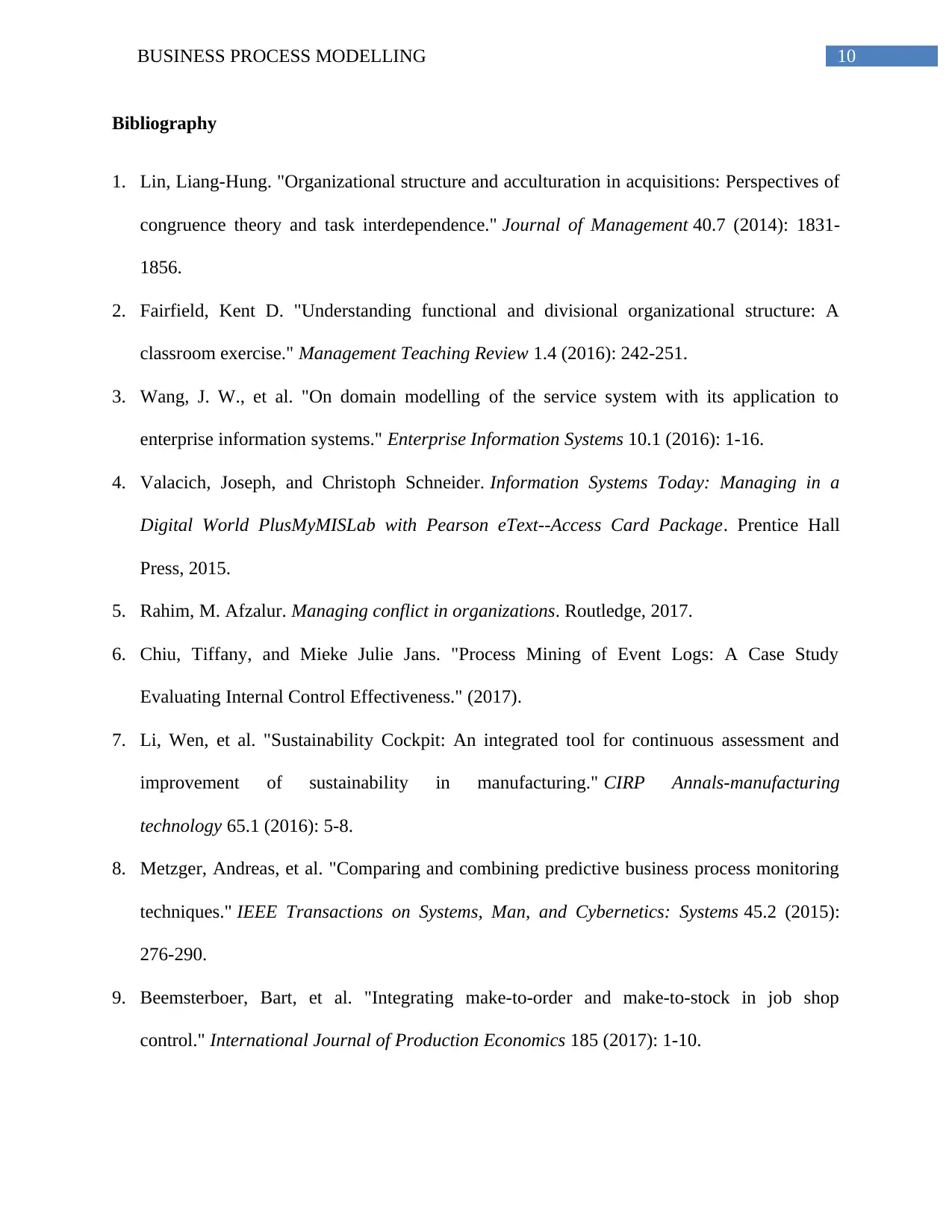
10BUSINESS PROCESS MODELLING
Bibliography
1. Lin, Liang-Hung. "Organizational structure and acculturation in acquisitions: Perspectives of
congruence theory and task interdependence." Journal of Management 40.7 (2014): 1831-
1856.
2. Fairfield, Kent D. "Understanding functional and divisional organizational structure: A
classroom exercise." Management Teaching Review 1.4 (2016): 242-251.
3. Wang, J. W., et al. "On domain modelling of the service system with its application to
enterprise information systems." Enterprise Information Systems 10.1 (2016): 1-16.
4. Valacich, Joseph, and Christoph Schneider. Information Systems Today: Managing in a
Digital World PlusMyMISLab with Pearson eText--Access Card Package. Prentice Hall
Press, 2015.
5. Rahim, M. Afzalur. Managing conflict in organizations. Routledge, 2017.
6. Chiu, Tiffany, and Mieke Julie Jans. "Process Mining of Event Logs: A Case Study
Evaluating Internal Control Effectiveness." (2017).
7. Li, Wen, et al. "Sustainability Cockpit: An integrated tool for continuous assessment and
improvement of sustainability in manufacturing." CIRP Annals-manufacturing
technology 65.1 (2016): 5-8.
8. Metzger, Andreas, et al. "Comparing and combining predictive business process monitoring
techniques." IEEE Transactions on Systems, Man, and Cybernetics: Systems 45.2 (2015):
276-290.
9. Beemsterboer, Bart, et al. "Integrating make-to-order and make-to-stock in job shop
control." International Journal of Production Economics 185 (2017): 1-10.
Bibliography
1. Lin, Liang-Hung. "Organizational structure and acculturation in acquisitions: Perspectives of
congruence theory and task interdependence." Journal of Management 40.7 (2014): 1831-
1856.
2. Fairfield, Kent D. "Understanding functional and divisional organizational structure: A
classroom exercise." Management Teaching Review 1.4 (2016): 242-251.
3. Wang, J. W., et al. "On domain modelling of the service system with its application to
enterprise information systems." Enterprise Information Systems 10.1 (2016): 1-16.
4. Valacich, Joseph, and Christoph Schneider. Information Systems Today: Managing in a
Digital World PlusMyMISLab with Pearson eText--Access Card Package. Prentice Hall
Press, 2015.
5. Rahim, M. Afzalur. Managing conflict in organizations. Routledge, 2017.
6. Chiu, Tiffany, and Mieke Julie Jans. "Process Mining of Event Logs: A Case Study
Evaluating Internal Control Effectiveness." (2017).
7. Li, Wen, et al. "Sustainability Cockpit: An integrated tool for continuous assessment and
improvement of sustainability in manufacturing." CIRP Annals-manufacturing
technology 65.1 (2016): 5-8.
8. Metzger, Andreas, et al. "Comparing and combining predictive business process monitoring
techniques." IEEE Transactions on Systems, Man, and Cybernetics: Systems 45.2 (2015):
276-290.
9. Beemsterboer, Bart, et al. "Integrating make-to-order and make-to-stock in job shop
control." International Journal of Production Economics 185 (2017): 1-10.
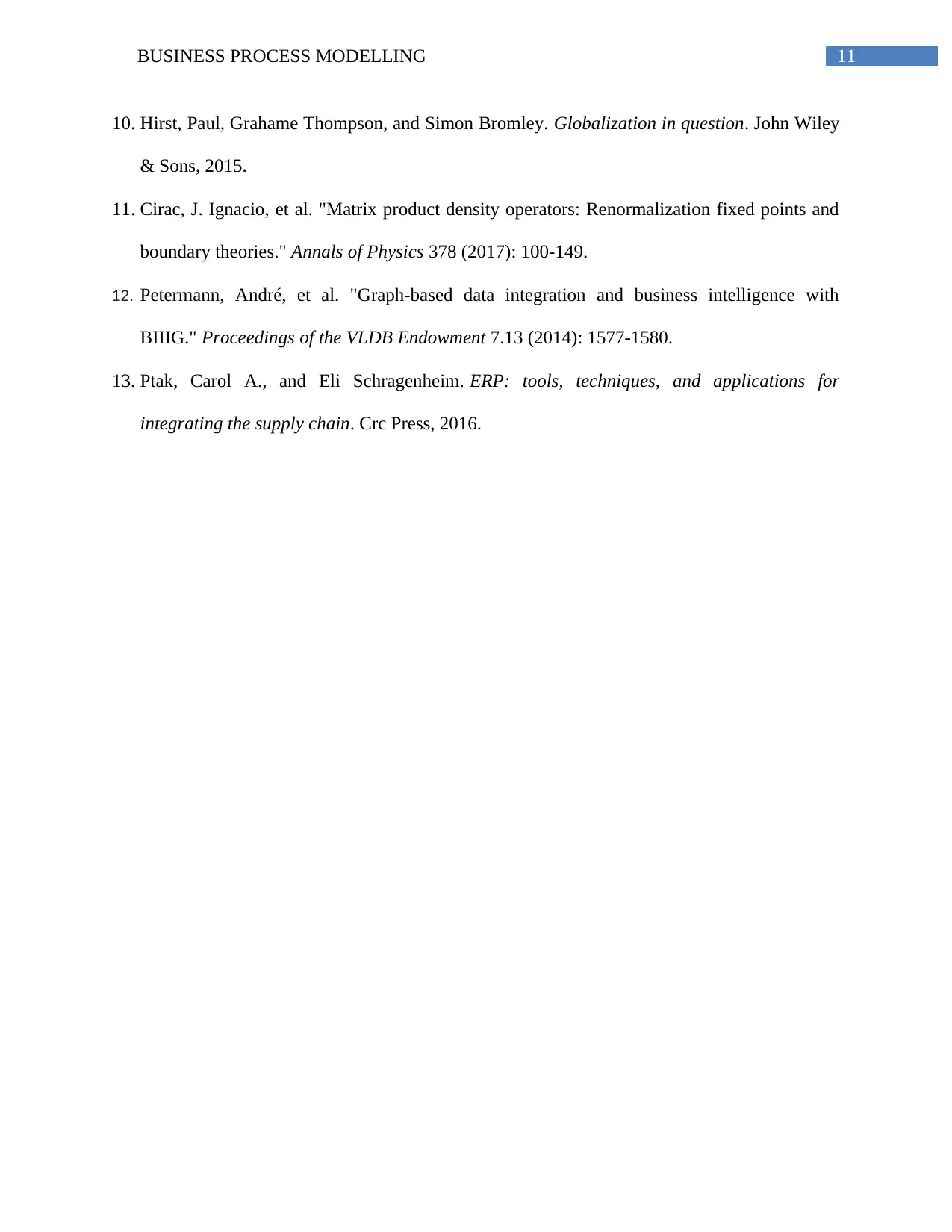
11BUSINESS PROCESS MODELLING
10. Hirst, Paul, Grahame Thompson, and Simon Bromley. Globalization in question. John Wiley
& Sons, 2015.
11. Cirac, J. Ignacio, et al. "Matrix product density operators: Renormalization fixed points and
boundary theories." Annals of Physics 378 (2017): 100-149.
12. Petermann, André, et al. "Graph-based data integration and business intelligence with
BIIIG." Proceedings of the VLDB Endowment 7.13 (2014): 1577-1580.
13. Ptak, Carol A., and Eli Schragenheim. ERP: tools, techniques, and applications for
integrating the supply chain. Crc Press, 2016.
10. Hirst, Paul, Grahame Thompson, and Simon Bromley. Globalization in question. John Wiley
& Sons, 2015.
11. Cirac, J. Ignacio, et al. "Matrix product density operators: Renormalization fixed points and
boundary theories." Annals of Physics 378 (2017): 100-149.
12. Petermann, André, et al. "Graph-based data integration and business intelligence with
BIIIG." Proceedings of the VLDB Endowment 7.13 (2014): 1577-1580.
13. Ptak, Carol A., and Eli Schragenheim. ERP: tools, techniques, and applications for
integrating the supply chain. Crc Press, 2016.
1 out of 12
Related Documents
Your All-in-One AI-Powered Toolkit for Academic Success.
+13062052269
info@desklib.com
Available 24*7 on WhatsApp / Email
![[object Object]](/_next/static/media/star-bottom.7253800d.svg)
Unlock your academic potential
© 2024 | Zucol Services PVT LTD | All rights reserved.




